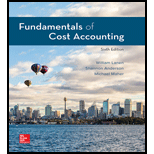
a.
Find the amount of service department costs which will be allocated to each of the production departments.
a.
Explanation of Solution
Cost allocation:
Cost allocation refers to the process where the common cost of the production and service rendered to the various departments of the business are distributed. It is used to calculate the actual cost attributed to a specific department.
The main purpose of cost allocation is providing detailed cost information to the management. It is essential because it is the process through which cost incurred in producing a product or service is determined. If costs are wrongly allocated a business would be wasting resources on products that are improperly determined as profitable.
It is used to calculate the actual cost attributed to a specific department.
Determine the amount of service department costs which will be allocated to each of the production departments by using the direct method:
| Costs | Member Department | Commercial Department | Total |
| Accounting | $8,000 (1) | $8,000 (2) | $16,000 |
| Computer Services | $12,320 (3) | $49,280 (4) | $61,600 |
| Total | $20,320 | $57,280 | $77,600 |
Table: (1)
Working note 1:
Compute allocation of the accounting cost for member department:
Working note 2:
Compute allocation of the accounting cost for the commercial department:
Working note 3:
Compute allocation of the computer services cost for member department:
Working note 4:
Compute allocation of the computer services cost for the commercial department:
b.
Identify whether the given situation is ethical or not.
b.
Explanation of Solution
Ethical dilemma:
The situation where the two or more perspectives are involved out of which neither is morally acceptable or unacceptable is termed as an ethical dilemma.
The changing of computer time for Member Department and Commercial Department as 20 percent and 30 percent respectively shows the unethical behavior of the controller. The activity might amount to fraud as well. It will lead to the wrong allocation of costs as well as manipulation to the cost records.
Thus, the activity of the controller is not ethical.
c.
Identify whether the given situation is ethical or not.
c.
Explanation of Solution
If the employee wages are used to allocate the cost of the accounting department; the cost allocation might not be appropriate because the number of employees is an effective measure for allocating costs of the accounting department. Use of the employee wages can be ethical if there is a direct relation between the wages of employees and the cost of the accounting department.
Thus, the being ethical or unethical of the situation depends on the relationship between the employee wages and the accounting department costs. If there is no direct link between the employee wages and the accounting department cost then this would be unethical.
d.
Find the amount of service department costs which will be allocated to each of the production departments by using the step method.
d.
Explanation of Solution
Cost allocation:
Cost allocation refers to the process where the common cost of the production and service rendered to the various departments of the business are distributed. It is used to calculate the actual cost attributed to a specific department.
The main purpose of cost allocation is providing detailed cost information to the management. It is essential because it is the process through which cost incurred in producing a product or service is determined. If costs are wrongly allocated a business would be wasting resources on products that are improperly determined as profitable.
It is used to calculate the actual cost attributed to a specific department.
Step method:
Step method allows the allocation of the cost to the production department and service departments. Unlike the direct method, it also allocates the cost of the service to various service departments. Allocation of the cost starts from the department that has provided the highest proposition of service to the department that has provided the least service. Step method allows only one-way allocation of cost among service departments.
Determine the amount of service department costs which will be allocated to each of the production departments by using the step method:
| Computer Services | Accounting | Member Department | Commercial Department | |
| Costs before allocation | $61,600 | $16,000 | $0 | $0 |
| Computer Services | ($61,600) | $30,800 (5) | $6,160 (6) | $24,640 (7) |
| Accounting | ($46,800) | $23,400 | $23,400 (8) | |
| Total | $0 | $0 | $29,560 | $48,040 |
Table: (2)
Working note 5:
Compute allocation of the computer services cost for the accounting department:
Working note 6:
Compute allocation of the computer services cost for member department:
Working note 7:
Compute allocation of the computer services cost for the commercial department:
Working note 8:
Compute allocation of the accounting cost for the commercial department:
e.
Find the amount of service department costs which will be allocated to each of the production departments by using the reciprocal method.
e.
Explanation of Solution
Cost allocation:
Cost allocation refers to the process where the common cost of the production and service rendered to the various departments of the business are distributed. It is used to calculate the actual cost attributed to a specific department.
The main purpose of cost allocation is providing detailed cost information to the management. It is essential because it is the process through which cost incurred in producing a product or service is determined. If costs are wrongly allocated a business would be wasting resources on products that are improperly determined as profitable.
It is used to calculate the actual cost attributed to a specific department.
Step method:
Step method allows the allocation of the cost to the production department and service departments. Unlike the direct method, it also allocates the cost of the service to various service departments. Allocation of the cost starts from the department that has provided the highest proposition of service to the department that has provided the least service. Step method allows only one-way allocation of cost among service departments.
Determine the amount of service department costs which will be allocated to each of the production departments by using the reciprocal method:
| Cost | Accounting | Computer Services | Member Department | Commercial Department |
| From: | ||||
| Costs before allocation | $16,000 | $61,600 | ||
| Accounting | ($52,000) | $10,400 (9) | $20,800 (10) | $20,800 (11) |
| Computer Services | $36,000 (12) | ($72,000) | $7,200 (13) | $28,800 (14) |
| Total | $0 | $0 | $28,000 | $49,600 |
Table: (3)
Working note 9:
Compute allocation of the accounting cost for computer services department:
Working note 10:
Compute allocation of the accounting cost for member department:
Working note 11:
Compute allocation of the accounting cost for the commercial department:
Working note 12:
Compute allocation of the computer services cost for the accounting department:
Working note 13:
Compute allocation of the computer services cost for member department:
Working note 14:
Compute allocation of the computer services cost for the commercial department:
f.
Identify whether the given situation is ethical or not.
f.
Explanation of Solution
If the highest costs are allocated to the member department, the method of cost allocation will not be implemented. Also, it will show that the member department is the only accountable departments for the costs of the entity. The reciprocal method can be applied for allocating costs to various departments. The allocation of more cost to the member department is not an ethical mean of allocation of costs.
Thus, the suggestion given by the controller is not ethical.
Want to see more full solutions like this?
Chapter 11 Solutions
Fundamentals of Cost Accounting
- Please explain the solution to this general accounting problem with accurate principles.arrow_forwardPlease provide the accurate answer to this general accounting problem using valid techniques.arrow_forwardI am looking for help with this general accounting question using proper accounting standards.arrow_forward
- I am searching for the correct answer to this general accounting problem with proper accounting rules.arrow_forwardI am looking for the correct answer to this general accounting question with appropriate explanations.arrow_forwardPlease provide the answer to this financial accounting question using the right approach.arrow_forward
- Business Its Legal Ethical & Global EnvironmentAccountingISBN:9781305224414Author:JENNINGSPublisher:Cengage
 Cornerstones of Cost Management (Cornerstones Ser...AccountingISBN:9781305970663Author:Don R. Hansen, Maryanne M. MowenPublisher:Cengage Learning
Cornerstones of Cost Management (Cornerstones Ser...AccountingISBN:9781305970663Author:Don R. Hansen, Maryanne M. MowenPublisher:Cengage Learning Individual Income TaxesAccountingISBN:9780357109731Author:HoffmanPublisher:CENGAGE LEARNING - CONSIGNMENT
Individual Income TaxesAccountingISBN:9780357109731Author:HoffmanPublisher:CENGAGE LEARNING - CONSIGNMENT





